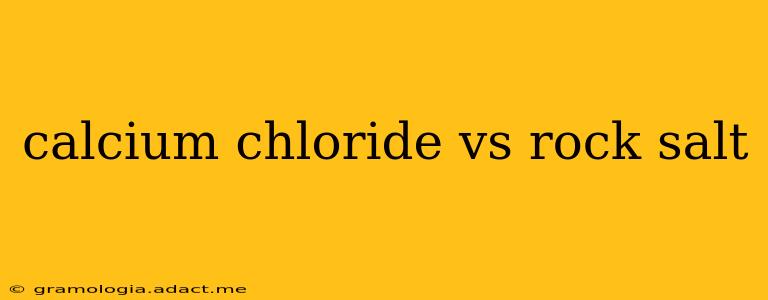Winter's icy grip can bring life to a standstill, making roads treacherous and sidewalks impassable. The battle against ice often pits two de-icing champions against each other: calcium chloride and rock salt (sodium chloride). While both effectively melt ice, they possess distinct properties that make them suitable for different applications and environments. This detailed comparison will explore their strengths and weaknesses, helping you choose the best option for your needs.
What is Calcium Chloride?
Calcium chloride (CaCl₂) is a chemical compound that readily absorbs moisture from the air, exhibiting a strong hygroscopic nature. This characteristic, coupled with its exothermic reaction with water (releasing heat), makes it a highly effective de-icer, even at extremely low temperatures. It works by lowering the freezing point of water, preventing ice formation and melting existing ice.
What is Rock Salt (Sodium Chloride)?
Rock salt, or sodium chloride (NaCl), is the common table salt we use in our kitchens. As a de-icer, it functions similarly to calcium chloride by lowering the freezing point of water. However, it's less effective at extremely low temperatures and requires more salt to achieve the same melting effect.
Calcium Chloride vs. Rock Salt: A Detailed Comparison
Here's a breakdown of the key differences between calcium chloride and rock salt, addressing common questions:
Which is More Effective at Lower Temperatures?
Calcium chloride significantly outperforms rock salt in sub-zero temperatures. Rock salt's effectiveness diminishes drastically below 20°F (-7°C), while calcium chloride remains effective down to -25°F (-32°C) or even lower, depending on the concentration. This makes calcium chloride the preferred choice for regions experiencing extremely cold winters.
Which is Better for the Environment?
Both calcium chloride and rock salt have environmental impacts. Rock salt is generally considered less environmentally damaging than calcium chloride in moderate quantities, although excessive use of either can harm vegetation and waterways. Calcium chloride can be more corrosive to concrete and metals, requiring careful consideration for its application. Sustainable de-icing practices, such as using smaller amounts strategically and employing alternative methods like sand, are recommended to minimize environmental impact regardless of the de-icer chosen.
Which is More Expensive?
Calcium chloride is generally more expensive than rock salt. This cost difference often stems from its superior performance at lower temperatures and its higher effectiveness per unit weight. While the upfront cost is higher, the increased effectiveness can result in cost savings by reducing the overall amount of de-icer needed.
Which is Safer for Pets and Plants?
Both rock salt and calcium chloride can harm pets and plants if ingested or if they come into direct contact with concentrated amounts. While both pose risks, rock salt might be slightly less damaging to plants than calcium chloride. It's crucial to use de-icers responsibly and minimize contact with pets and plants. Always wash pets' paws thoroughly after walks on treated surfaces.
Which is Better for Concrete?
Rock salt is generally less corrosive to concrete than calcium chloride. Calcium chloride's high salt concentration and its ability to absorb moisture can accelerate concrete degradation over time. For applications near concrete structures, rock salt is often the safer option.
Which one is better for driveways?
The best choice for your driveway depends on your climate and budget. For areas with consistently cold temperatures, calcium chloride's superior effectiveness justifies its higher cost. In milder climates, rock salt might be a more economical and environmentally friendly option. Always follow the manufacturer's instructions for application rates.
Which melts ice faster?
While both melt ice, calcium chloride generally melts ice faster than rock salt due to its exothermic reaction with water. This rapid melting action is particularly beneficial in situations where quick ice removal is crucial.
In conclusion, the "best" de-icer depends on individual needs and priorities. Carefully consider the factors outlined above—temperature, cost, environmental impact, and safety—to make an informed decision. Responsible use and responsible disposal practices are crucial regardless of the de-icer chosen to minimize environmental damage and protect your property and the surrounding environment.
